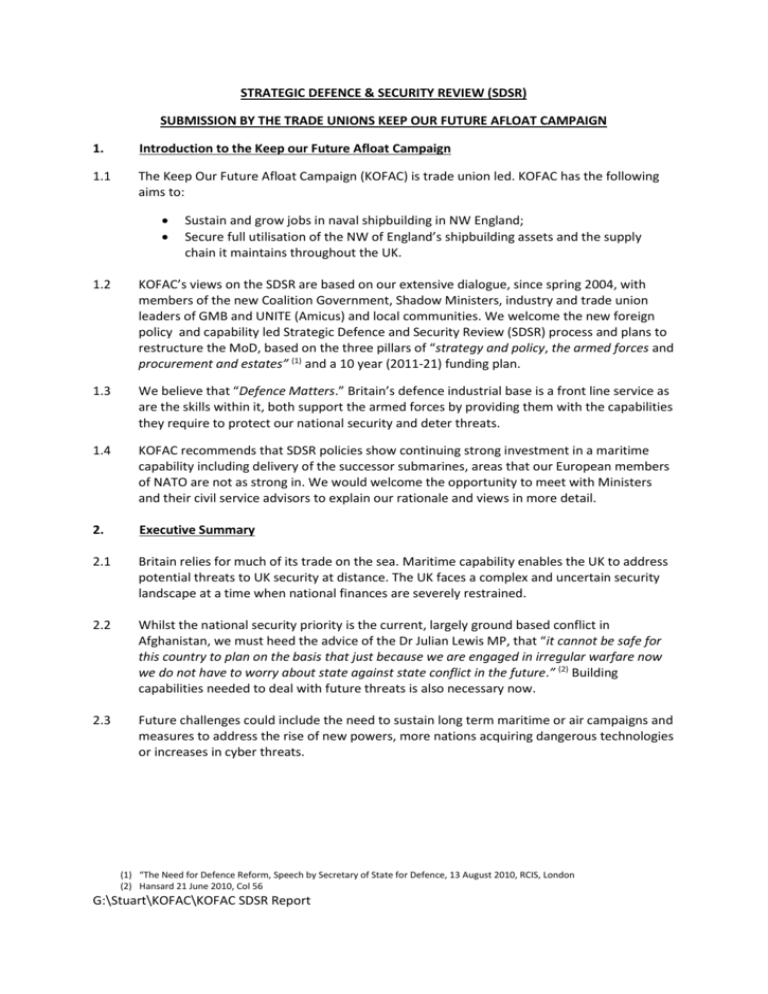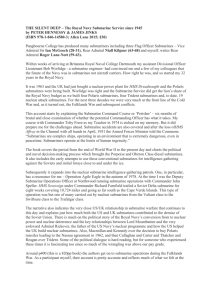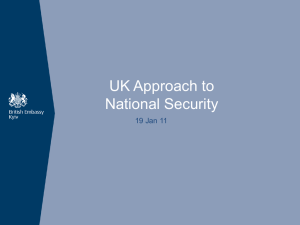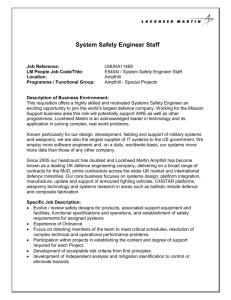KOFAC SDSR Report
advertisement

STRATEGIC DEFENCE & SECURITY REVIEW (SDSR) SUBMISSION BY THE TRADE UNIONS KEEP OUR FUTURE AFLOAT CAMPAIGN 1. Introduction to the Keep our Future Afloat Campaign 1.1 The Keep Our Future Afloat Campaign (KOFAC) is trade union led. KOFAC has the following aims to: Sustain and grow jobs in naval shipbuilding in NW England; Secure full utilisation of the NW of England’s shipbuilding assets and the supply chain it maintains throughout the UK. 1.2 KOFAC’s views on the SDSR are based on our extensive dialogue, since spring 2004, with members of the new Coalition Government, Shadow Ministers, industry and trade union leaders of GMB and UNITE (Amicus) and local communities. We welcome the new foreign policy and capability led Strategic Defence and Security Review (SDSR) process and plans to restructure the MoD, based on the three pillars of “strategy and policy, the armed forces and procurement and estates” (1) and a 10 year (2011-21) funding plan. 1.3 We believe that “Defence Matters.” Britain’s defence industrial base is a front line service as are the skills within it, both support the armed forces by providing them with the capabilities they require to protect our national security and deter threats. 1.4 KOFAC recommends that SDSR policies show continuing strong investment in a maritime capability including delivery of the successor submarines, areas that our European members of NATO are not as strong in. We would welcome the opportunity to meet with Ministers and their civil service advisors to explain our rationale and views in more detail. 2. Executive Summary 2.1 Britain relies for much of its trade on the sea. Maritime capability enables the UK to address potential threats to UK security at distance. The UK faces a complex and uncertain security landscape at a time when national finances are severely restrained. 2.2 Whilst the national security priority is the current, largely ground based conflict in Afghanistan, we must heed the advice of the Dr Julian Lewis MP, that “it cannot be safe for this country to plan on the basis that just because we are engaged in irregular warfare now we do not have to worry about state against state conflict in the future.” (2) Building capabilities needed to deal with future threats is also necessary now. 2.3 Future challenges could include the need to sustain long term maritime or air campaigns and measures to address the rise of new powers, more nations acquiring dangerous technologies or increases in cyber threats. (1) “The Need for Defence Reform, Speech by Secretary of State for Defence, 13 August 2010, RCIS, London (2) Hansard 21 June 2010, Col 56 G:\Stuart\KOFAC\KOFAC SDSR Report 2.4 Our armed forces must be equipped so they can operate flexibly, adapt and be able to respond to threats knowing that they are supported by a cost effective defence industrial base which has good visibility from the MoD and the Treasury of future capability requirements and funding available. 2.5 KOFAC recommends that SDSR policies should: (3) (4) (5) (6) (7) Sustain the present defence budget, not cut it. However, if it has to be cut, this should be by a minimal amount and where practicable, past delay of spend policies should be reversed to save money.(3) Prioritise the war we are in now in Afghanistan. It must also prepare for potential future threats to our nation’s security (see para 3.8 below) such as a concerted naval challenge from major nations,(4) ie: Russia’s to expand their navy. These threats must be countered at range before they are able to directly endanger the UK. Mirror American policy – the UK should also “rethink what and how we buy, shifting the investment towards systems that provide ability to see and strike along the full spectrum of conflict and seek to give our armed forces a war fighting edge.” (5) Define the kind of navy we need in years to come including tasks to protect safe passage of our merchant fleet, move armed forces by sea and into the littoral environment quickly and safely, and use of vessels that can give hard support on the ground and delivery of the strategic deterrent.”(6) Include maritime proposals that are well funded and focused upon: o “A submarine force with expanded roles that is prepared to” (support the USA) “conduct more missions deep inside an enemy’s battle network;”(5) o Retention of the strategic nuclear deterrent in a new fleet of 4 SSBN nuclear powered submarines, because a submarine based ballistic missile capability is the optimum survivable solution for the deterrent capability; o A fleet of 8 Astute class submarines to exploit advantages in sub-surface operations and hedge against potential changes in undersea warfare; o Delivery of Type 26 frigates to replace aging frigates; o Re-equipping existing Type 45,Type 22, Type 23 ships and new Type 26 fleet with the BAE Systems 155mm naval gun at modest cost; o Modernisation of the Royal Navy and RFA’s logistics support capability. Sustain the UK’s strong alliance with the USA and develop, where practicable, and where security considerations allow, partnerships with EU allies such as France and Germany. However to achieve greater interoperability with others may be difficult given the MoD’s observation that “we have underestimated the challenges of operating in multinational operations in the past.” (7) Set a framework for a new Defence Industrial Strategy ‘2’ defining those strategic sovereign capabilities that the UK needs to retain, such as the ability to design, build and operate nuclear powered submarines and improving affordability of defence acquisition programmes. The National Audit Office (NAO) Major Projects Report 2009 HC 85-1 Session 2009-2010 explained that the Astute programme will cost £539m more due to slowing production The Russian State Re-armament Programme 2007-15 in Arctic Security Challenges and Issues, January 28 2010 and “Strategy for the Long Haul: The US Navy Charting a Course for Tomorrow’s Fleet” (R Work) 7 February 2009 at www.csbaonline.org Speech by Robert M Gates, Secretary of State for Defense, US Dept of Defense, 3 May 2010 at the Navy League Sea-Air-Space Exposition, National Harbour, Maryland Alison Seabeck MP, 21 June 2010 Hansard Col.76 Adaptability and Partnership Green Paper, MoD February 2010 G:\Stuart\KOFAC\KOFAC SDSR Report 2.6 Emphasise why jobs and capacity to deliver defence equipment in the UK must be maintained by committing to “a longer term approach to our ordering of ships and a need to end wasteful delays to production schedules” and “slowing of the rate of build of the carriers for instance, which has increased costs of the future carriers by £600m.”(8) SDSR must also consider the need to ensure: Air defence of the United Kingdom and whether to increase use of unmanned aircraft systems for intelligence gathering, surveillance, reconnaissance and attack. Joint land based intervention to protect UK security interests overseas. Effective multi-national operations. The advantages to be gained in supporting expeditionary joint forces, through improved UK based naval firepower using a 155mm naval gun and small scale introduction of the M777 gun into the UK’s armoury. Effective cyberspace deterrent capability. 3. A Foreign Policy Led Strategic Defence and Security Review 3.1 The UK’s new distinctive foreign policy is founded on the fact that, “we are at war in Afghanistan –our top priority in Foreign Affairs,”(9) the need to prevent nuclear proliferation and other emerging threats, help create prosperity and exploit potential opportunities, identified in July 2010 by the Foreign Secretary(9) including: Extending Britain’s global reach and influence, inspiring other nations and people using communications in a networked world and Protecting Britons abroad; Significant build up of bilateral relations and reinvigorate diplomacy in Latin America; A modernised NATO Alliance and an unbreakable alliance with the United States complemented by partnerships with France and Germany ; Projecting forces overseas instead of homeland based defence; Dealing with widely dispersed, often difficult to access security threats. 3.2 In looking to implement an SDSR based on a greater level of bilateral alliances, it is important to be mindful that the MoD has clearly stated that it has “underestimated the challenge of operating in multinational operations.”(10) 3.3 Foreign policy’s emphasis on exerting influence abroad may also lead to enhanced opportunities under the SDSR for UK Industry to deliver defence exports using the expertise of the UKTI Defence & Security Support Organisation and thereby sustain key industrial and design skills. (8) Hansard 21 June 2010, Col 104, Penny Mordant , MP for Portsmouth North (9) Britain’s Foreign Policy in a Networked World, Speech by the Foreign Secretary, London 1 July 2010 (10) Chapter 2, Paragraph 2.2, page 19 Adaptability and Partnership Green Paper, Cm7794, MoD February 2010 G:\Stuart\KOFAC\KOFAC SDSR Report 3.4 The Foreign policy led Strategic Defence & Security Policy must be adequately funded by HM Treasury. The budget must fund: 3.5 “Maritime capabilities are not a luxury, they are a necessity for a global trading island with many overseas interests.”(12) The SDSR needs to incorporate a maritime strategy It should also explain how the navy can help win the war in Afghanistan and address emerging threats such as: 3.6 The strategic deterrent and capability as a national priority and not wholly seek to have it funded out of the MoD’s budget. Ability to intervene with a naval task force on a large scale using a naval task force of at least 3 submarines and 40 ships. 20 ships and 2 submarines would be needed for medium scale intervention.(11) UK’s air defence and strike capabilities as well as ‘air bridge’ support to complement “sea basing” and tactical sea logistic movements of expeditionary capability. Adequate helicopter and ‘drone’/ISTAR support for our joint forces in theatre. The rise of powerful land based maritime reconnaissance – strike networks which may need a new air/sea doctrine. Potential for major disruptions in ongoing undersea competition including the need to fight under conditions of acoustic parity and to counter new generations of undersea weapons, sensors and vehicles. Potential new global naval competition.(13) Strong maritime forces are a core UK defence capability which have a vital role to deter and contain threats as much as to deliver lethal force where necessary,(12) enabling Britain to use air strike and air defence capability and to intervene ‘off our goal line’ overseas where we need to: Keep the sea lanes open – our trade depends on it. Ensure the UK and its allies can have freedom of action through sea basing and safe sea borne transport of joint forces and logistical sustainment from the sea into operational theatre. Maintain robust r + d, design and industrial bases capable of responding to any future concerted naval challenge. Exploit the potential of ships now in use or production and improving their networking capability and adoption of the UK designed 155mm naval gun. (11) Ministry of Defence, Defence Planning Assumptions, paragraph 33, 2009 (12) First Sea Lord, 7 July 2010, RUSI Future Maritime Operations Conference (13) Strategy for the Long Haul – The US Navy Charting a Course for Tomorrow’s Fleet, February 2009 www.csbaonline.org G:\Stuart\KOFAC\KOFAC SDSR Report 4. SDSR Policy – Sustaining the Unique Utility of Nuclear Powered Submarines 4.1 The SDSR policy must state that nuclear powered submarines play a unique and vital role in our national defence by providing “the most sophisticated and flexible weapons that we have to exercise sea control,”(14) which in the case of “Astute submarines can deter almost any other navy from putting to sea against us.” (15) It will therefore follow that there is “an enduring need for Britain to retain the capability to design, build, operate, maintain and dispose of nuclear powered submarines.”(16) Specifically the SDSR must say that submarines give the Royal Navy a unique range of capabilities to keep the sea lanes open, to deter, fight to win and maintain undersea supremacy that helps safeguard the sea lanes in the 21st century, by operating unsupported globally and remaining at sea for extended periods. These capabilities include: 4.2 Hosting the Trident missile system which is the UK’s independent strategic nuclear deterrent. Protecting the strategic deterrent. Stealth, mobility, firepower and advanced sensors which make them the weapon of choice across the full spectrum of military operations. Operability in open ocean and littoral seas including force protection for other maritime assets. Intelligence gathering so critical to irregular war effort using advanced intelligence, surveillance and reconnaissance capability. Land attack through precision strike using Tomahawk cruise missiles. Special forces insertion. With two existing submarines having ceased operational service in 2009 and 2010 and one more due to go next year and more in 2013, 2017, 2019, 2021 and 2022, Britain will have a reducing submarine fleet . The five aging Trafalgar class submarines need to be progressively replaced from 2013 to 2022 with new Astute class submarines (Source: Hansard 1 June 2009, Col.23W). 4.3 KOFAC advocates that the SDSR commits to Funding the build and operation of 8 Astute class attack submarines and a fleet of 4 successor to Vanguard class SSBN ballistic missile submarines to carry Britain’s existing strategic nuclear deterrent to 2050. Augmenting its larger undersea combat systems with smaller vehicles, distributed sensors and weapon pods perhaps operating in conjunction with the USA’s planned bottom drop capability. Design work in the latter part of the SDSR timeframe to ensure the UK retains its undersea capability beyond the Astute class of submarine. (14) Chief of Naval Operations, Admiral Gary Roughhead, 17 June 2009, BSBA (15) Bernard Jenkin, MP for Harwich and North Essex, Hansard 21 June 2010, Col.74 (16) MoD, Submarine Enterprise Collaborative Agreement Impact Assessment http://www.mod.uk/NR/rdonlyres/D929BC42-19684BD8-95E4-BE8CB71F576E/0/SecaImpactAssessmentFinalVersion.pdf. “The capability provided by nuclear submarines is therefore unique and of vital importance to national defence”. G:\Stuart\KOFAC\KOFAC SDSR Report 4.4 The SDSR needs to make it clear that the UK is prepared to fund the nuclear submarine programme as a long term programme to keep the submarine industrial base strong and vibrant. With this commitment, submarines can be made even more affordable. SDSR must re-affirm the DIS 2005 policy to sustain a sovereign capability to design, build, operate and dispose of nuclear powered submarines, and use the Submarine Enterprise Collaboration Agreement as a foundation for delivering the current Astute and successor submarine programmes, reducing through life cost and ensuring value for money. 4.5 A steady optimum drumbeat of orders is required. It is absolutely crucial that the optimum “drumbeat” of submarine orders - delivery of a boat every 22-26 months is maintained. This policy is needed because of the need to : Replace aging submarines with 21st century stealth capability. Keep skills in the supply chain together. Ensure that the Submarine Enterprise does not become unaffordable. Ensure continued build of Astute submarines occurs as it is vital to the future, allowing Britain to de-risk the next deterrent submarine programme by maturing new technology in Astutes before they go to sea in the first of class successor boat. 4.6 “Capabilities (to build submarines) take decades to create and will take decades to recreate if we give them up now in the face of a one off financial crisis.”(17) KOFAC’s view is that the UK Submarine Enterprise has been optimised in terms of its size and programme such, that any small disruption to overall programme assumptions has the potential for a dramatic impact on the business, which rapidly becomes unsustainable from a skills retention perspective. The House of Commons Defence Select Committee has evidence from Ministers that “If you don’t exercise your submarine design capability; if you don’t exercise those specialist submarine build techniques; in short, if you don’t build submarines regularly, you haemorrhage the capability to build submarines very quickly and it costs more.”(18) 4.7 It should also recognise that there are few opportunities for diversification to mitigate any hiatus in demand. 4.8 It is for these reasons that the SDSR must set out the build programmes for the Astute and successor submarines so there is a “smooth transition from the Astute programme to the successor deterrent.”(19) 4.9 Looking at the five tests set out by the Secretary of State for Defence on 13 August 2010, in relation to nuclear powered submarines, KOFAC has concluded the following. (17) (18) (19) Bernard Jenkin. MP for Harwich & North Essex, Hansard 21 June 2010, Col.74 Lord Drayson, House of Commons Defence Select Committee, The Future of the UK’s Strategic Nuclear Deterrent, the Manufacturing and Skills Base, paras 57 and 59 Statement by Secretary of State for Defence, 25 March 2010 G:\Stuart\KOFAC\KOFAC SDSR Report 4.9.1 Cost Savings in Years 0-5; 5-10 and 10+ 4.9.1.1 Previous Policy to defer spending should be reversed in order to save money. The stretching of the Astute programme to 28 months increases costs in later years. The MoD, in 2009, decided “to slow the production of boats 2-7 will lead to a £539m cost increase after 2013-14, represented by a net increase in forecast costs of £400m arising as a result of reducing expenditure by £139m up to 2013-14” will also “slip the entry into service of each subsequent boat by an average of 9 months”(20), which “is forecast to leave a period between 2015 and 2021 when there will be a shortfall in submarine availability against (MoD’s) stated requirement.” This is in part because “further extensions to the Trafalgar fleet are not considered feasible.”(20) Given the vital role submarines play this policy is not considered a prudent way forward. The same applies to carriers where costs have gone up by £600m. 4.9.2 Capability Implications 4.9.2.1 The existing Trafalgar class submarines are aging, five are between 24 and 29 years old, all pre-date 1991 and need to be replaced. Astutes will improve stealth and capability to counter 21st century undersea threats and increase the ability to support land forces. Rebaselining is needed to avoid the shortfall in capability identified by NAO beyond 2015. 4.9.3 Operational Implications 4.9.3.1 A steady drumbeat delivery of modern submarines will improve operational availability of the submarine fleet ensuring it can do more to support joint forces and avoid the capability gap predicted in 5 years time. 4.9.4 Ability to Regenerate the Capability 4.9.4.1 The programme to build Astutes has been optimised in terms of its size and programme. Any small disruption to the overall programme assumptions has potential for a dramatic impact on the business which rapidly becomes unsustainable from a SQEP skills perspective. The National Audit Office in the MoD’s “The UK’s Future Nuclear Deterrent Capability (HC 1115, 2007-2008) reinforced this view saying “the time delay between the construction of the Vanguard class submarines and the beginning of the Astute programme meant that key skills and submarine building experience had been lost.” Rand also echoed this concern in page 8 of “Trends in the UK’s Naval Shipbuilding Industrial Base: Lessons for the United States” paper of 6 April 2006 presented to the House Armed Services Committee. Regenerating submarine capability is hugely costly and difficult to do. Therefore a regular drumbeat of orders is necessary. 4.9.5 The Risks the Capability Protects Us From 4.9.5.1 Astute submarines provide enhanced capability to counter anti-submarine warfare, whilst improving intelligence gathering, land attack capability, protection of the strategic deterrent and the ability to deploy special forces. The successor submarine will guarantee our ultimate deterrent in its most survivable form. (20) The National Audit Office (NAO) Major Projects Report 2009 HC 85-1 Session 2009-2010 explained that the Astute programme will cost £539m more due to slowing production G:\Stuart\KOFAC\KOFAC SDSR Report 5. The Strategic Nuclear Posture and the Submarine Based Deterrent 5.1 America’s, February 2010, Quadrennial Defence Review Report “Rebalancing the Force” identified nuclear weapons as “a source of special concern for the United States and its allies because of their extreme lethality and long term effects. If regional adversaries succeed in fielding even small numbers of such weapons, the security of key regions could be severely complicated.” 5.2 KOFAC believes that the SDSR should state that “As long as nuclear weapons exist”, there is a need to “sustain safe, secure and effective nuclear forces”... to “play an essential role in deterring potential adversaries and reassuring allies”. Our policy would then mirror that of the USA. Russia and China are currently modernising their nuclear capabilities and we should also still regard Russia’s nuclear force as a significant factor in determining how much and how fast the UK is prepared to reduce its nuclear capability. In terms of nuclear posture, KOFAC considers that Britain should only use nuclear weapons on the same basis as the USA would, i.e. “in extreme circumstances to defend the vital interests of the UK or its allies and partners.”(21) The nuclear deterrent is fundamental to our ability to deter the destructive forms of aggression. The best way to do this is to retain its submarine based strategic nuclear deterrent. 5.3 KOFAC welcomes the Coalition Government’s policy for maintenance of the strategic deterrent. Britain should sustain the policy of “continuously at sea” deterrent patrols with a fleet of 4 submarines, with at least one submarine always at sea on patrol, each submarine being ‘at notice to fire’ measured in days as is now the case. 5.4 Our submarine based strategic nuclear deterrent is a national defence asset. It should not be regarded as a financial burden. It is the ultimate guarantor of our national security and it is the most credible form of deterrent. It is because it has this role that its funding should be additional to the existing MoD defence budget. 5.5 The UK needs to ensure a replacement (successor) class for the existing aging fleet of Vanguard class submarines (SSBN), which use 1980s technology, is ready by 2024-2026 to provide the same level of strategic deterrence as the current class by which time the first of the Vanguard class will be over 34 years old and ready to retire. New submarines rather than further refits of aging existing submarines are best way of ensuring the existing strategic deterrent missiles remain effective. 5.6 A fleet of four new submarines, each with 12 missile silos designed to carry existing D5 trident missiles must be introduced by 2024, or by no later than 2026. 5.7 The Coalition Government’s policy to ensure value for money is achieved throughout the successor programme is supported. By 2011 £780million will have been invested in submarine development (22) so continuing the programme will reap benefits. The forecast cost base, identified in Hansard on 3 June, Col.77W, showed that each submarine could cost £2.7-3.5 billion out of an overall package cost of: (21) US Strategic Nuclear Forces: Background Developments and Issues, Congressional Research Service, 14 July 2009 (22) Secretary of State for Defence reply to Dr Whiteford MP, Hansard 3 June 2010, Col.78W G:\Stuart\KOFAC\KOFAC SDSR Report Submarines Warheads Infrastructure Total £11-14b £ 2b £ 3b £20b It may that the Value for Money Review of the system costs now underway could see the £20b cost reduced. 5.8 To help achieve better value for money from sharing expertise and costs where possible, design and build of successor should take place in conjunction with the USA’s development of the planned new SSBN-X fleet. USA and UK Governments’ collaboration on the production of future successor and USA SSBN(X) submarine missile compartments is supported. 5.9 It is crucially important that the time tabling of the design and build of the successor to Vanguard class is not “moved to the right” so as to open up workload gaps, which will put capabilities and skills that are irreplaceable in the supply chain and shipyards at risk. 5.10 If decisions have to be taken to move successor start dates back in time, consideration should be given to filling the ‘gap’ in the workload with an additional Astute class submarine. Non submarine work will not suffice to sustain suitable qualified or experienced personnel to work on submarines. 5.11 If successor does not proceed there would be serious consequences for the UK’s ability to design and manufacture nuclear powered submarines. 5.12 Having regard for the five tests set out by the Secretary of State for Defence in his speech on 13 August, KOFAC concluded the following. 5.12.1 Cost Savings in Years 0-5, 5-10 and 10+ 5.12.1.1 There should be cost savings for the MoD budget, by treating deterrent submarine build as a national asset and design funding should continue. Most construction funding will start to impact on UK budgets beyond 2014-15 by which time the economy will have improved. 5.12.2 Capability Implications 5.12.2.1 The long lead time for building trident carrying submarines means work needs to continue on the project to ensure that by 2026, a replacement for 34 year old vessels is available and able to continue ‘continuously at sea patrols’ without risk of a gap. 5.12.3 Operational Implications 5.12.3.1 See above. New boats will reduce the risk of the deterrent being more detectable in the 2020s, 2030s and beyond. G:\Stuart\KOFAC\KOFAC SDSR Report 5.12.4 Ability to Regenerate the Capability 5.12.4.1 The programme to build Astutes has been optimised in terms of its size and programme. Any small disruption to the overall programme assumptions has potential for a dramatic impact on the business which rapidly becomes unsustainable from a SQEP skills perspective. The National Audit Office in the MoD’s “The UK’s Future Nuclear Deterrent Capability (HC 1115, 2007-2008) reinforced this view saying “the time delay between the construction of the Vanguard class submarines and the beginning of the Astute programme meant that key skills and submarine building experience had been lost.” Rand also echoed this concern in page 8 of “Trends in the UK’s Naval Shipbuilding Industrial Base: Lessons for the United States” paper of 6 April 2006 presented to the House Armed Services Committee. Regenerating submarine capability is hugely costly and difficult to do. Therefore a regular drumbeat of orders is necessary. 5.12.5 The Risks the Capability Protects us From 5.12.5.1 The capability is our ultimate security, protecting against state on state aggression and deterring others from using nuclear weapons. 6. Surface Warships and RFA Fleet Support 6.1 A fleet of 59 surface warships complement the Royal Navy’s 11 nuclear powered submarines now in service. These warships are supported by a fleet of RFA ships. Table 1 The Royal Navy Fleet in 2010* Number of ships Aircraft Carriers 3 Amphibious Ships 3 Type 42 Destroyers 5 Type 45 Destroyers 2 Type 22 Frigates 4 Type 23 Frigates 13 Type 26 0 Antarctic Patrol Ship 1 Hunt Class Minehunters 8 Sandown Class Minehunters 8 Survey Ships 4 Offshore Patrol Vessel 1 River Class Patrol Vessels 3 Gibraltar Squadron 2 Faslane Squadron 2 (* Hansard 23 June 2010, col.237W – Parliamentary answer. Note: excludes 14 fast training boats and submarines) G:\Stuart\KOFAC\KOFAC SDSR Report 6.2 Surface warship modernisation must continue. The existing fleet should be enhanced by more Type 45 destroyers and the planned Type 26 Future Surface Combatant programme aimed at replacing the current fleet of 17 Type 22 and Type 23 frigates currently in service. 6.3 Where possible, new naval ships and existing frigates and destroyers should be equipped with the same calibre of gun as are in use for fire support onshore. This means greater use of the 155mm calibre ammunition and gun barrels. 6.4 The modernised Royal Navy needs adequate RFA support. 7. 155mm Naval Gun and M777 Gun Capability 7.1 The 4.5” naval gun currently equips Type 22, 23 frigates and the first batch of Type 45 destroyers. It could also be used on the Type 26 ships. A 155mm BAE Systems developed naval gun, an American 5” gun or an Italian 5” gun are understood to be in contention to be used on future vessels. KOFAC recommends the prototype 155mm naval gun under development at BAE Global Combat Systems which potentially has a unit cost lower than overseas based alternatives, but which needs around £10m funding to facilitate a production scale gun. SDSR should commit funding to refine the prototype so it can be introduced to enhance naval firepower capability and : Sustain UK design and manufacturing capability for naval artillery ‘in country’; Give UK third generation naval firepower capability; Introduce new technology which reduces through life cost and obsolescence inherent in the 4.5” technology; Improve joint force capability for land attack. 7.2 Defence costs could be reduced in the long term by converting the 4.5” gun capability to 155mm capability, which also offers the added advantage of inter-changeability of use of standard ‘onshore’ field gun ammunition, thereby introducing further cost savings. 7.3 The SDSR may wish to consider providing for UK joint forces to order a small number of M777 howitzer guns for artillery support to joint forces. At half the weight of conventional 155mm systems the gun can be deployed by medium-lift helicopter quickly and beyond the reach of roadside bombs to otherwise inaccessible areas, extending its reach over the theatre of operations." In Afghanistan its performance exceeds expectations. The gun can fire the "smart" rounds up to 40 km accurately enough to give supporting fire to be brought down much closer to friendly troops. 8. Defence Industrial Strategy 2 8.1 “Defence Matters” – the UK defence industry is a front line service which supports 305,000 direct jobs, 10% of UK manufacturing jobs, £35b of revenue and 17,000 jobs in NW England. It makes a very substantial contribution to wealth and job creation and “represents high levels of employment in some economically less well-off parts of the United Kingdom” (Hansard 21 June2010, Col.53). Every job in defence creates 1.6 jobs elsewhere in the economy. Investing in defence can help Britain’s economic recovery and can contribute significantly towards the Coalition Government policy to create a more balanced economy. It sustains highly skilled jobs in many of the most economically disadvantaged regions of the UK helping make them important hubs for advanced technology, growth in apprenticeships and extensive workforce training G:\Stuart\KOFAC\KOFAC SDSR Report 8.2 In an Assisted Area like Barrow, which is remote from engines of growth, the defence sector delivers 5,100 jobs directly, 4,000 indirectly and around 2,000 induced. It also supports recruitment and training of hundreds of apprentices and graduates as well as putting over £200m in to the local economy in wages(23) and it is a high source of Gross Value Added. Barrow in Furness is a superb national asset – one of the few locations for the building of nuclear powered submarines in the world. There is a large proportion of the workforce undertaking lifelong learning through joint shipyard and trade union backed programmes. 8.3 SDSR must contain policies to sustain and revitalise its defence industrial base to sustain military and industrial effectiveness and maintain our technological advantage in defence technology and capability. An up to date Defence Industrial Strategy will provide a framework for improving efficiency and reducing costs. SDSR must set a consistent, realistic long term strategy for shaping the structure and capabilities of the defence industrial base; make a clear statement of the industrial capability that the Coalition Government wishes to keep onshore and what is needed to deliver operational sovereignty; create conditions for a continuing supply of critical components and that supply chains are not compromised by over reliance on overseas suppliers; ensure critical skills are not lost. 8.4 Much defence industrial capability cannot easily be replaced. It cannot be switched on or off or later reconstituted or adapted from capabilities drawn from other industries. We have shown what the impact of this can be which is a view reinforced by the National Audit Office and outlined earlier in this submission 8.5 The SDSR should set out how the MoD’s Submarine Enterprise Collaborative Agreement will retain a sovereign capability to deliver, operate and maintain nuclear submarines. 8.6 The SDSR should therefore commit to: A force level of 8 attack nuclear powered submarines and 4 successor submarines. Supporting the supply chain where 50 to 60% of the contract value for a nuclear powered submarine is sub-contracted out across the whole of the UK. 9. Conclusions 9.1 The new SDSR should focus on: (23) prevailing in today’s wars; preventing and deterring conflict; preparing to defeat adversaries; sustaining the existing strategic deterrent. BAE Systems Submarine Solutions: Key Messages, February 2010 G:\Stuart\KOFAC\KOFAC SDSR Report 9.2 The UK may move towards greater bilateral co-operation with USA and maybe countries like France. We need to avoid duplicating in quantity capabilities held in large numbers by our NATO alliances. We therefore need to sustain indigenous capability that cannot be easily complemented by European NATO partners. Maritime power including submarines and specialist amphibious power projection forces are key areas where UK excels as is military air lift. 9.3 It would be wrong to cut the Royal Navy nuclear submarine force which contributes 57% of the EU nuclear attack submarine capability and it would be wrong to cut our amphibious capability which contributes 40% of Europe’s capability. Submarines are potent platforms with strategic reach stealth endurance armed with a weapons system that is a strategic deterrent in itself. For further information contact: Secretariat, Keep Our Future Afloat Campaign, Waterside House, Bridge Approach, Barrow in Furness, LA14 2HE, Email:sklosinski@furnessenterprise.co.uk, Tel: 01229 820511 www.navalshipbuilding.co.uk G:\Stuart\KOFAC\KOFAC SDSR Report








